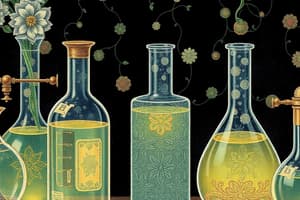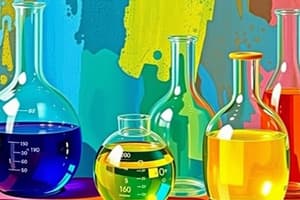Podcast
Questions and Answers
What is the primary purpose of a beaker in a laboratory setting?
What is the primary purpose of a beaker in a laboratory setting?
- To mix and grind substances.
- To hold liquid or solid samples. (correct)
- To measure precise volumes.
- To securely hold a burette.
Which laboratory equipment is specifically designed to securely hold test tubes?
Which laboratory equipment is specifically designed to securely hold test tubes?
- Test tube brush
- Test tube rack (correct)
- Test tube holder (correct)
- Erlenmeyer flask
What laboratory tool uses the venturi effect to produce a vacuum?
What laboratory tool uses the venturi effect to produce a vacuum?
- Aspiration pump
- Aspirator (correct)
- Suction flask
- Vacuum chamber
Which instrument is used to dispense small quantities of liquids?
Which instrument is used to dispense small quantities of liquids?
What is the function of a mortar and pestle in the laboratory?
What is the function of a mortar and pestle in the laboratory?
In laboratory procedures, which item is utilized to facilitate the removal of liquids through filtering?
In laboratory procedures, which item is utilized to facilitate the removal of liquids through filtering?
Which piece of laboratory equipment is used for holding small amounts of samples and covering beakers?
Which piece of laboratory equipment is used for holding small amounts of samples and covering beakers?
What is the role of a burette clamp in laboratory procedures?
What is the role of a burette clamp in laboratory procedures?
Flashcards
Aspirator
Aspirator
This device creates a vacuum using the venturi effect, where a fluid flows through a narrowing tube.
Beaker
Beaker
A cylindrical container used for holding and mixing liquids or solids. They are often used for reactions and holding samples.
Erlenmeyer Flask
Erlenmeyer Flask
A conical flask with a narrow neck, ideal for holding liquids, mixing solutions, and carrying out chemical reactions.
Burette Clamp
Burette Clamp
Signup and view all the flashcards
Test Tube Brush
Test Tube Brush
Signup and view all the flashcards
Test Tube Rack
Test Tube Rack
Signup and view all the flashcards
Porcelain Spatula
Porcelain Spatula
Signup and view all the flashcards
Pipette
Pipette
Signup and view all the flashcards
Study Notes
Laboratory Glassware and Equipment
-
Aspirator: A device that produces a vacuum using the venturi effect. Fluid (liquid or gaseous) flows through a narrowing tube.
-
Beaker: Used as a reaction container or to hold liquid or solid samples.
-
Erlenmeyer Flask: Useful for containing reactions or holding liquid samples.
-
Burette Clamp: A laboratory tool to securely hold a burette during precise volume measurement procedures.
-
Test Tube Brush: Used for cleaning test tubes.
-
Test Tube Rack: Holds test tubes upright when containing chemicals and upside down to dry. Made of wood, metal, or plastic.
-
Porcelain Spatula: Used to take small amounts of powdered compounds in a laboratory setting.
-
Medicine Dropper: Used for adding liquids drop by drop.
-
Stirring Rod: Used for mixing liquids or solids and liquids.
-
Funnel: Used for funneling liquids from one container to another or for filtering when equipped with filter paper.
-
Wire Gauze: Placed on a ring, supports beakers to be heated with Bunsen burners.
-
Metal Spatula: Used for scraping and transferring small amounts of powders or solids.
-
Test Tube Holder: Used for holding test tubes when they cannot be touched directly.
-
Clay Triangle: Placed on a ring attached to a ring stand, supports a funnel, crucible, or evaporating dish.
-
Pipette: Used for dispensing small quantities of liquids.
-
Evaporating Dish: Used to separate liquids and solids from a solution by allowing water to evaporate.
-
Laboratory Tripod: A three-legged platform that supports flasks and beakers.
-
Laboratory Thermometer: Measures boiling points during experiments and the temperature of substances.
-
Mortar and Pestle: Used to grind and mix substances.
-
Watch Glass: Used for holding small samples or covering beakers or evaporating dishes.
-
Test Tube: Used to hold, mix, and heat for chemical experiments.
-
Crucible Tongs: Used for grasping and taking a hot crucible.
-
Alcohol Lamp: Used for heating, sterilization, and combustion in a laboratory.
-
Crucible and Cover: Used to heat solid chemicals at high temperatures.
-
Bunsen Burner: A type of gas burner used in many chemistry procedures for heating, combusting substances, and sterilizing objects.
-
Triple Beam Balance: Used to measure the mass of small objects.
Laboratory Policies
-
Classroom Discipline: Maintaining discipline is essential in the laboratory. Eating, smoking, and playing are prohibited. Handling toxic chemicals warrants special attention.
-
Class Attendance: Students are expected to attend the entire duration of the class for the complete learning experience. Absence is marked when a student leaves the classroom before the conclusion of the class.
-
Personal Protective Equipment (PPE): Laboratory gowns or aprons and surgical gloves must be worn during experiments to adequately protect the user from possible harmful effects.
-
Laboratory Materials: Students with the correct materials needed for the experiment are permitted. Students sent out of the laboratory due to lacking the necessary materials will be marked absent.
-
Manuals: Authorized printed copies of the laboratory manual are mandatory and will be given credit for the experimental result. No photocopies are graded and given credit. Numerical computations should use scratch paper, and the final answer should be written using the space designated on the manual. Answers need to be presented with the correct number of significant figures. Measurement units must be indicated.
Studying That Suits You
Use AI to generate personalized quizzes and flashcards to suit your learning preferences.



